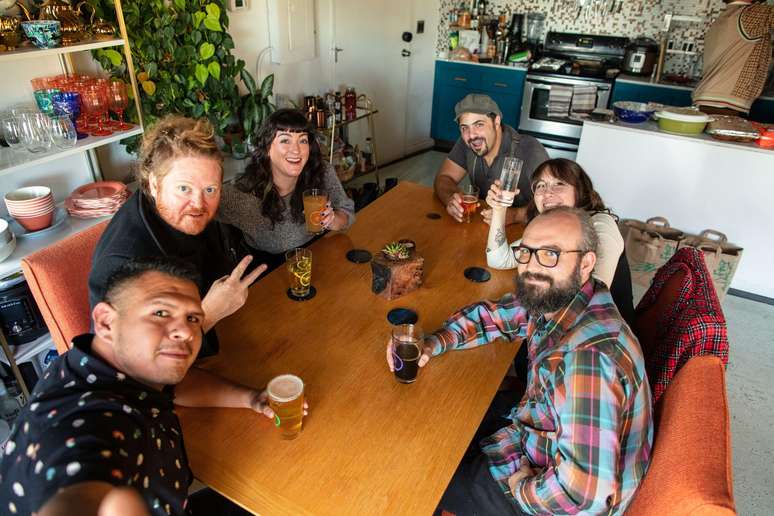The rising cost of living and loneliness among people have made community living an attractive alternative in many places around the world.
Living with strangers? Always occupied bathrooms, unwashed dishes in the kitchen and people listening to loud music in the next room when you go to sleep?
Well, maybe it doesn’t have to be that way.
The costs of purchasing and renting properties remain high. And the World Health Organization recently declared loneliness a global health problem.
These factors have meant that community living has started to attract media attention – and the number of people adopting this type of accommodation is increasing.
Living with other people can bring more benefits than harm. The big question is whether society is ready for this.
Rosie Kellett is 30 years old, lives in London and is a food writer.
In 2020 he went through a separation and needed to find a new place to live. Kellett discovered through social media that there were vacancies in a warehouse, an old industrial building repurposed for housing.
She estimates that in Hackney Wick, the east London neighborhood where she lives, there are around 100 communities living in warehouses. But your community is different from others.
“We organized ourselves a little differently,” he says.
Kellett lives with six other people, aged in their 30s. Every week, they each deposit 25 pounds (about R$160) into a shared bank account, to cover the costs of maintenance and kitchen materials, garbage bags, cleaning products and dinner for all residents.
Every evening one person cooks. In a community chat group, people confirm whether they will be home for dinner, whether they want to save their plate for when they arrive later, or whether they are bringing a guest.
There are household chores and community meetings.
“You have to do several surveys on WhatsApp to get a half-hour window where everyone can participate,” Kellett tells the BBC. “But we try to hold meetings as regularly as possible. That way, if someone is unhappy with their tasks or wants to discuss some topic, the situation doesn’t get worse.”

For her, the best thing about living in a community is that there is always someone at home. And the residents feel like family. “I’ve never felt this way about people I’ve lived with before.”
Kellett says it is very difficult to find a house in London, due to the housing crisis. “I think it’s becoming impractical to live right here… to me it’s like we’ve fallen into a little crack in the system.”
Of course there are also disadvantages. Kellett has difficulty taking time for herself.
“It can be very difficult to separate myself from the big table full of people,” he says. “And even if you decide not to attend a party, you will still feel it.”
“We have two showers and two toilets, which residents share without major problems. But one washing machine is simply not enough.”
‘Condominium association’
People who live in the community warehouse usually stay there for a few years. But there are other communal homes created for people who intend to live permanently in the same place.
Creal Zearing is 36 years old and lives with her husband and three-year-old daughter in a residential community in Madison, Wisconsin.
“My husband bought the first unit we lived in,” she tells the BBC. “He started looking for him when we had been dating for about three months.”
“I knew what community housing was and I thought it was a good thing. If we stayed together, I might end up enjoying it. And sure enough, everything worked out between us.”
They live in Arbco shared accommodation, which includes two blocks of flats and some family homes. Each unit has its own bedroom, bathroom and kitchen.
About 100 people live there, including families with children and single elderly people.
“Technically our cohousing is a condominium association, legally it is structured like that,” explains Zearing.
“Our home is ours, but we pay a condo fee every month, which helps pay for the community spaces we use and includes some insurance coverage for our home.”
Each resident prepares meals every few weeks and there are social events, such as parties and a monthly gathering where everyone sings. Fortnightly condominium meetings and committee and administration meetings are also held.
“I work full time,” Zearing explains. “But there is a group of people who are retired and probably do more regular tasks together that I can’t.” But the group expects each resident to contribute four hours of work a month.
“What I really appreciate is that we have a great community of moms and dads,” she says. “As a new mother, I was really able to lean on these parents for guidance.”
Zearing also loves coming home from work, tired, and simply taking her daughter to play in the yard with the other children. She always has friends and company at her disposal.
But not everything works perfectly. The community just had a big meeting about participation.
“Many of us who are actively engaged feel like we’re doing everything we can. But you still see some people who are probably doing nothing,” he says.
“And there is a lot of invisible work going on.” Her husband has received criticism a few times after suggesting new ways of doing things and encountering resistance.
“Intentional Communities”
There is a huge variety of community housing setups in the Western world, created for a variety of reasons.
In the UK, the Covid-19 pandemic has helped to increase interest in community housing. Members of a successful center in Suffolk, England, told BBC News in 2023 that community housing helped them overcome the cost of living crisis.
“It can be very confusing,” says Penny Clark, co-director of the UK housing organization Diggers and Dreamers. Clark specializes in “intentional communities” — residences where, by academic definition, five or more unrelated people live together voluntarily.
He explains that there is also cohabitation, in which people have their own independent home, defined community spaces and the community is self-managed.
In housing cooperatives, ownership is shared, but ownership does not always function as an intentional community.

There is also a relatively new sector, cohousing. This is where Clark works as a consultant.
Here a company creates a building with independent apartments or studios, as well as common areas. But these are not intentional communities either.
“And finally there are the communes, which are very rare in the UK these days,” he explains.
“According to academic definitions, what differentiates communes from other types of communities is that there is a high degree of income sharing. Income goes into the pot and people only spend together.”
What about Rosie Kellett’s warehouse and people who live in integrated share houses, with people they consider close friends or even family? Well, these can be considered intentional communities, according to Clark; perhaps they are simply less organized and more organic, because the number of members is smaller.
Clark believes many people may turn to community housing because the housing market is under such pressure. Other people seek out this type of accommodation because they want to be more environmentally sustainable.
And, of course, in today’s atomized society, with family members living far from the city where they were born, social connection is an important factor. In fact, research indicates that people who live in intentional communities have the same quality of life as the happiest people in society.
But is this way of life good for everyone?
“There are certainly tradeoffs,” according to Clark. “The work in community life can be considerable: sometimes it works very badly and people leave very shaken.”
And it’s not even easy to create a new co-housing community from scratch. Available land is scarce, financial risks are great and banks are reluctant to lend money.
“We’re in a system that has certain assumptions about what a good life and a good home are,” Clark says. “And community housing doesn’t fit into that premise. We have this mentality in society that privacy is a good thing, that having things is a good thing.”
Sharing your living space is not an aspiration, he explains. “The idea of a good home is a great home, which you own.”
But existing communities like Arbco often receive inquiries from people who want to move there.
In London, Rosie Kellett shared two lifestyle videos on Instagram. Many people contacted her asking if they could move into the warehouse too.
“I felt really bad because we don’t accept new residents,” she says. “There is definitely a desire for more spaces like this, but you have to organize it yourself.”
Tips for living in housing communities
– Hold periodic meetings among residents to resolve any problems.
– Be prepared to work in some way. Everyone needs to collaborate.
– Set aside some time away from colleagues.
Read the original version of this report (in English) on the site BBC Culture.
Source: Terra
Ben Stock is a lifestyle journalist and author at Gossipify. He writes about topics such as health, wellness, travel, food and home decor. He provides practical advice and inspiration to improve well-being, keeps readers up to date with latest lifestyle news and trends, known for his engaging writing style, in-depth analysis and unique perspectives.







